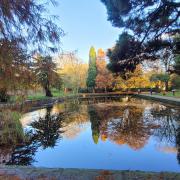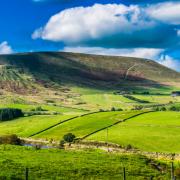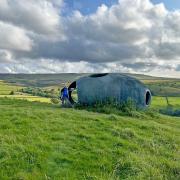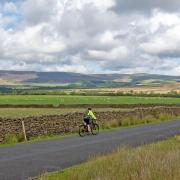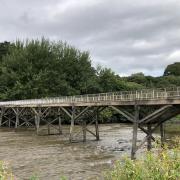The churchyards around Morecambe Sands are full of men and women caught by the tide. But one man has spent 50 years in the Queen’s service guiding travellers to safety. Terry Marsh met him.
At the start of his novel-based-on-fact, The Maid of Buttermere, Melvyn Bragg writes of the expanse of Morecambe Bay viewed from a point near Hest Bank from where travellers in the days before a convenient road to Cartmel and into the Furness peninsula would strike out on the ‘over-sands route’. Even on a good day, it was a perilous venture, and many died in the crossing. Hundreds lie buried in the grounds of Cartmel Priory and elsewhere. Many more were simply never found.
There is a good degree of probability that this ‘over-sands’ route has been in use for more than 5,000 years, indeed from Neolithic times. In the Middle Ages, the main use of the route was probably monastic, providing access to the religious houses of Furness. But the bay crossing continued to be used after the Dissolution of the Monasteries and served a more secular purpose for almost 500 years thereafter. Before 1800, the low-tide routes across Morecambe Bay were of major importance. Even after the railways arrived in the mid-19th century, the way across the bay was used by cattle drovers, packhorse trains and the poor.
Today, the walk across Morecambe Bay in the company of the guide has evolved into a recreational pursuit...and what a joy that has turned out to be! Fifty years ago, a earnest-faced young man, Cedric Robinson by name, then living in Ravenstown, took up the ancient office of Queen’s Guide to the Kent Sands of Morecambe Bay. Two years earlier he had married Olive Nickson at St John’s church in Flookburgh, and were blessed with a daughter, Jean, in January 1963. It was time, he tells me, to face up to earning a wage. Not that becoming the Queen’s Guide helped overmuch, not at a salary of £15 per annum, plus the tied Guide’s Cottage on Cart Lane, Grange, a place where Oliver Cromwell is said to have spent a night. Centuries later there was still no running water or electricity.
Quite when guides were first appointed is now lost in time, but there are documented bay crossings from Roman times, none of which could have been contemplated without the knowledge that such a traverse was possible, most probably using the skills of local fishermen. Cedric Robinson is the latest in a long line of guides. The first known, a man named Edmondson, appears in 1501 establishing a pedigree that Cedric Robinson feels privileged to share. Cedric’s immediate predecessor was William Burrow, who held office from 1950. When he decided to retire, Cedric was encouraged to apply for the job. In the event, there was only one other candidate.
Cedric, supported by his lovely wife, Olive, whom he met in 1960, is a remarkable man; someone everyone would want as a friend. He is unfailingly amiable and polite, when at times he would be more than justified in being quite the opposite. And, in spite of his advancing years (he reached his 80th birthday earlier this year), still rattles across the sands at a pace that many younger folk have difficulty keeping up with. What makes him especially charming, for those few who get to know him, is an innocence of all things and places beyond his domain. For someone who has been honoured by, and met, the Queen, this is quite remarkable. Even going to Keswick is like going to a foreign country for Cedric and Olive; they have been, of course, and do actually travel widely, but they are very home-centric, and Cedric has lived most of his life within a stone’s throw of the Bay.
He was born in the tiny Lancashire village of Flookburgh, in the same house that his father (who lived to be more than 100) was born in. Cedric went to the village school, but it was not a place he liked, and he would escape whenever he could, run home and hide under the table, which is where the teacher invariably found him.
On a recent bay walk, he talked about having resumed his love of playing the trombone, which harked back to a time when he did so in the Flookburgh Silver Band. His musicality was evident from an early age, and he sang in the church choir for seven years. But he always had a yearning for the sands, which, to him, was a vastly different world. Like many of his generation, he left school at 14, and quickly had to become accustomed to working a horse and cart on his own, and to go selling shrimps in Carnforth with his sister, and working with his father.
This early introduction to life on the sands has been the foundation on which he has developed his walks across the bay, the first of which he led in April 1964, a group of paratroopers on military exercise. It was to be a month later before the second walk, but then, gradually, Cedric’s weekends filled with a growing number of organised walks, and a vastly increasing number of participants, occasionally reaching more than 1,000 at a time. Today, the number of folk who have faithfully followed Cedric across the bay, including royalty and many celebrities, runs into tens of thousands; he has no idea how many.
Such has been Cedric’s commitment to Morecambe Bay and those who wanted to walk across it, that he has received numerous awards and countless thousands of letters of thanks and appreciation, including an MBE, which he received in 1999.
Life at Guides Farm goes on; if Cedric is not out in the bay, fishing or preparing a route for a walk, he’s somewhere on his smallholding, tending to his animals, feeding, gathering eggs, mucking out...and all with a tireless energy that gives you the impression this particular ‘Sand Pilot’ is solar powered. But perhaps the best assessment of the duties Cedric performs comes from an excellent book by Alastair Bruce – Keepers of the Kingdom: The Ancient Offices of Britain – which concludes ‘Of all the Queen’s men, the Queen’s Guide across the shifting sands of Morecambe Bay is perhaps the most useful service of them all.’
Stand out in the vast expanse of the bay with Cedric on any day, and you soon get a keen sense of how very pertinent that sentiment really is.
Cedric, at your service
Cedric met the Queen and sat next to Princess Anne during a recent Royal visit to the region, he has never escorted his employer across the sands. However, he did take the Duke of Edinburgh on a horse-drawn trip across the bay in 1985.
‘Once we set off he asked me a lot of questions. As we were coming to the other end of the bay there was a crowd gathered and they all started applauding,’ said Cedric. ‘The Duke said “Stand up Mr Robinson, it is you they are clapping, not me!”
















